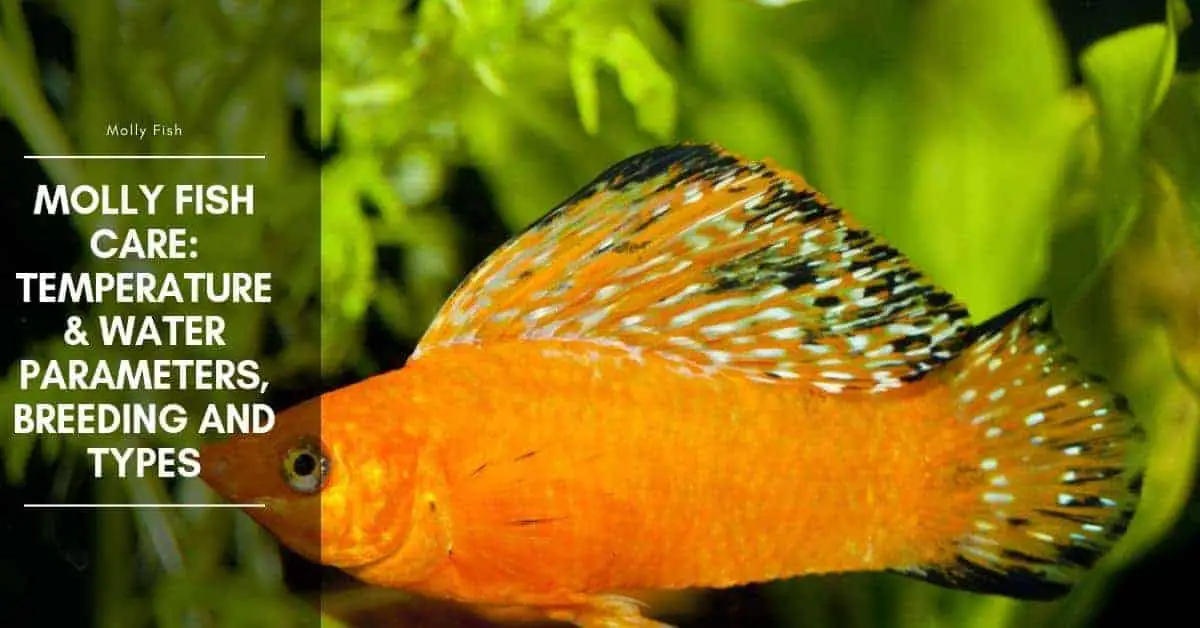With the wide variety of colors and types of mollies available, it is no wonder that the Molly fish is such a widespread species among fish keepers.
Molly Fish Temperature
Mollies are a tropical fish and will typically require a heater as they need their water to be kept at stable temperatures between the range of 78 and 82 degrees Fahrenheit.
Molly Fish Lifespan
These fish have an average lifespan of about five years and typically get to be large around 4 inches. Molly’s are very social fish, so it’s usually recommended that you get at least four preferably more for your tank.
Because of their large size though a minimum tank size of 10 gallons is typically recommended. However, a bigger tank of 30 gallons would be more suitable for them, as these guys tend to be pretty big swimmers.
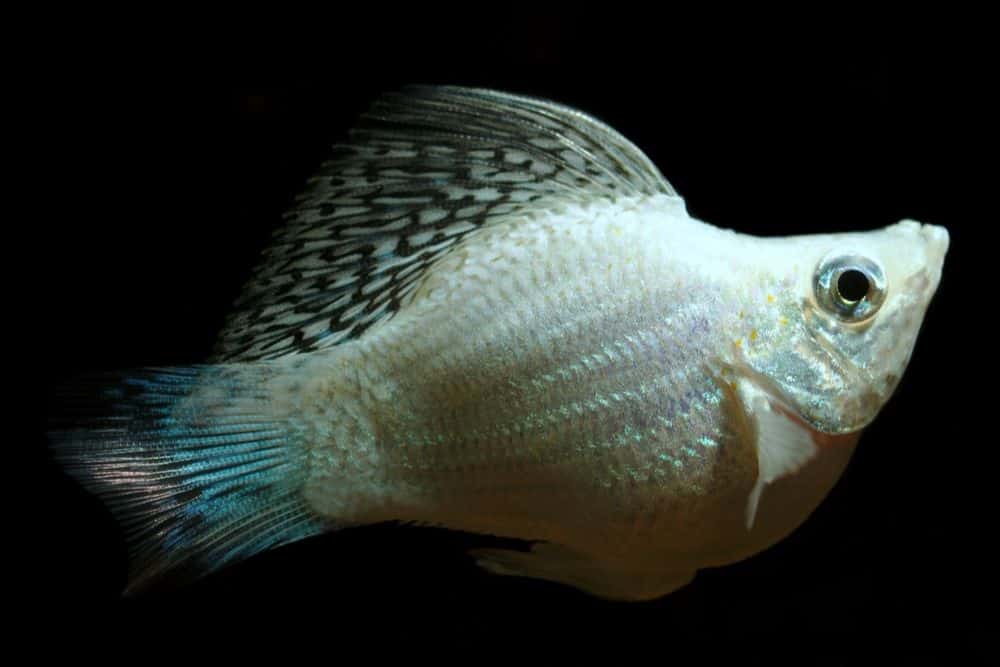
Black Molly Water Parameters and pH Level
These fish do prefer harder water, and they need to be kept at a pH range between 7.5 and 8.5. So many hobbyists with softer water will tend to keep things like crushed coral in the tank to help buffer the water.
What type of water do molly fish need?
Molly enjoy hard water. In nature, their habitats are usually found in freshwater streams and rivers that have high mineral content, including calcium carbonate. The reason for this is it makes the water harder which allows less soluble substances to be absorbed by the mollies since water hardness affects how much-dissolved solids can dissolve from the water into the fish’s body.
In simpler terms, hard water means it is harder for substances to dissolve in and be absorbed by mollies’ bodies. They can live in softer waters if they are maintained at a higher pH and calcium hardness, but this isn’t what they prefer.
Can you use tap water for your Molly fish?
Tap water can vary in its saltiness, mineral content, and pH. If you want to use tap water for your molly fish, it is recommended that you check the parameters of the tap water for several weeks before keeping any fish in it.
Check with your local authorities about what contaminants are found in your area’s waters. Some areas may have heavy metals or other chemical contaminants in the water that are harmful to fish.
API STRESS COAT Aquarium Water Conditioner 16-Ounce Bottle
Tetra AquaSafe Plus, 8.45 Ounces, aquarium Water Conditioner And Dechlorinator, Model Number: 46798162681
$10.19 (as of December 16, 2025 09:02 GMT +03:00 - More infoProduct prices and availability are accurate as of the date/time indicated and are subject to change. Any price and availability information displayed on [relevant Amazon Site(s), as applicable] at the time of purchase will apply to the purchase of this product.)API TAP WATER CONDITIONER Aquarium Water Conditioner 16-Ounce Bottle
$8.48 (as of December 16, 2025 09:02 GMT +03:00 - More infoProduct prices and availability are accurate as of the date/time indicated and are subject to change. Any price and availability information displayed on [relevant Amazon Site(s), as applicable] at the time of purchase will apply to the purchase of this product.)You’ll want to test the pH, Nitrates, Ammonia, Phosphate, Hardness, and Alkalinity of your tap water for several weeks to give you a good idea of what’s going on with the water.
Your molly will most likely be fine if your tap water is tested and found to be better quality every time you check it. If your molly becomes ill over several weeks while being exposed to what you thought was good water, analyze everything in your tank and try to identify why they are not doing well.
Molly Fish Breeding
The Molly fish is a livebearer, and when you are getting mollies for your tank, it’s also important to know that males do tend to be aggressive when it comes to breeding. So they might harass your females. So you will want to have at least three females per male in your tank.
Male mollies do tend to be more streamlined in shape with larger fins and tend to have a more pointed anal fin, while female mollies will typically have bulkier bodies shorter fins, and more fan-shaped anal fin.
What Do Molly Fish Eat?
One other thing to love about mollies is that they will feed on algae. All mollies will naturally feed on algae they are also considered omnivores, and they will be typically fed a varied diet of high-quality flake food vegetables such as blanched zucchini or cucumber bloodworms baby brine shrimp, and Daphnia.
Molly Fish Types
Poecilia Mexicana (Shortfin Molly)
The coloration of Poecilia Mexicana Mollies in the wild is variable, ranging from shades of blue to yellowish and silvery tones. Darker coloration is seen in some individuals, notably in the race known as Limantour’s Molly. The wild Shortfin Molly is the ancestor of the Black Molly, the most popular of the domesticated varieties available today.
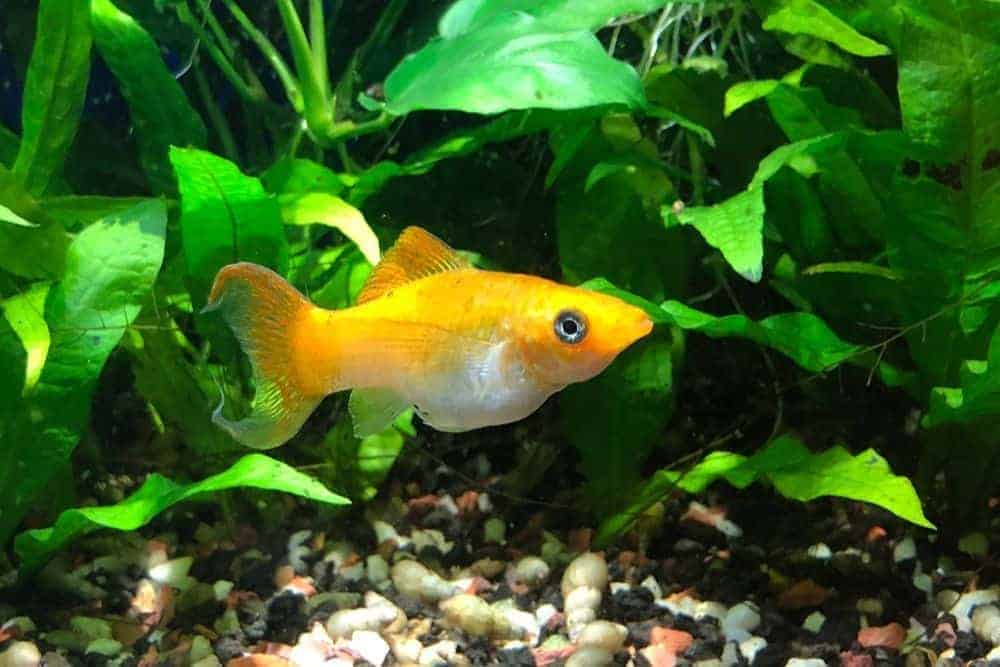
The Black Molly was created in the 1930s by a breeder in New Orleans, although the exact route of its development is now unclear. Its distinctive matt-black coloration almost certainly derives from melanistic examples of the wild form. Like the Pacific Mexican, the Black Molly has a low dorsal fin, a relatively elongated body, and a compact, rounded caudal fin.
The black coloration has also been combined with marbled and balloon characteristics. Black varieties look good in an aquarium alongside bright orange swordtails. These fish often fare better when kept in slightly brackish water. This seems to make them less vulnerable to the parasitic illness known as “ich,” or white spot, which shows up clearly against the color of their bodies.
Females typically produce 40–300 offspring per brood.
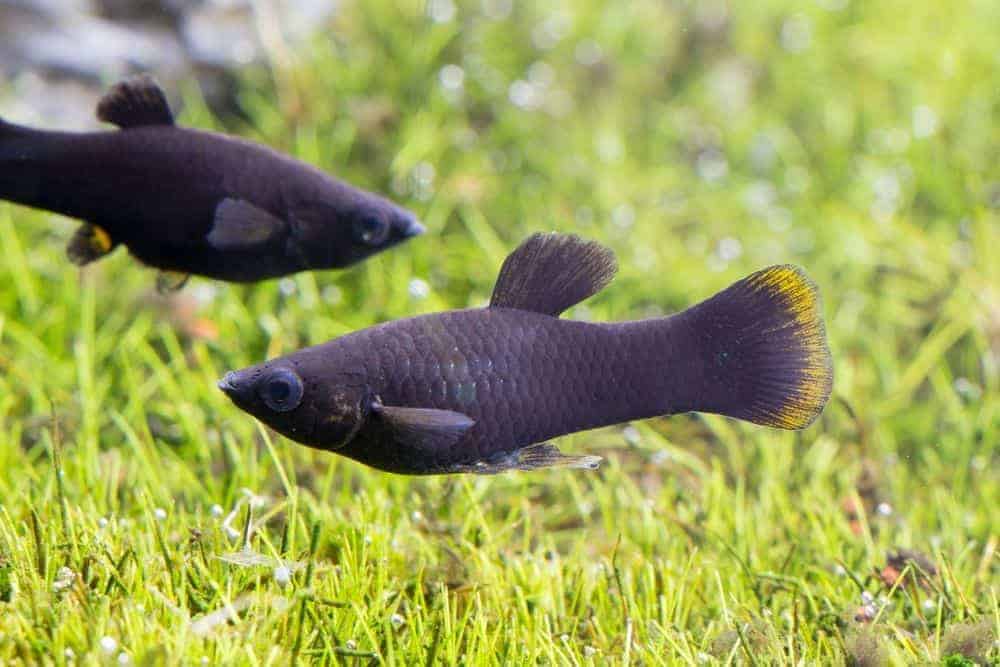
Amazon Molly (Poecilia Formosa)
The Amazon Molly is believed to be a wild hybrid of the Sailfin and Pacific Mexican species. Its common name refers not to its distribution (which extends from parts of the southern U.S. into Central America) but to the fabled all-female tribe of South America. Only one in every 10,000 of these fish is a biological male, and the arrangement of the males’ chromosomes suggests that they are sterile.
The offspring produced by female mollies are therefore clones of their mothers, making the Amazon Molly the first unisexual vertebrate to be discovered. Female Amazons still need to mate to give birth, so they attract males of other molly species, by interrupting their courtship rituals, and also simply by living alongside them so that the males eventually come to identify with them.
While sperm produced by these males triggers the development of an Amazon Molly’s eggs, it does not fertilize them. The eggs contain the complete genetic blueprint of the young, rather than just the half normally contributed by female vertebrates that reproduce sexually
Sailfin Molly (Poecilia Latipinna)
The Sailfin Molly has a long, tall dorsal fin that runs almost the entire length of the fish’s back. Sailfin Mollies have been used extensively in the development of today’s domesticated variants, which exist in a wide range of colors.
These relatively large mollies must be kept under good water conditions; if conditions are less than ideal, they display their unhappiness by rocking gently back and forth in the same spot—a behavior known as shimmying. Wild Sailfin Mollies usually require a brackish environment, and this may also be of benefit to their domesticated relatives.
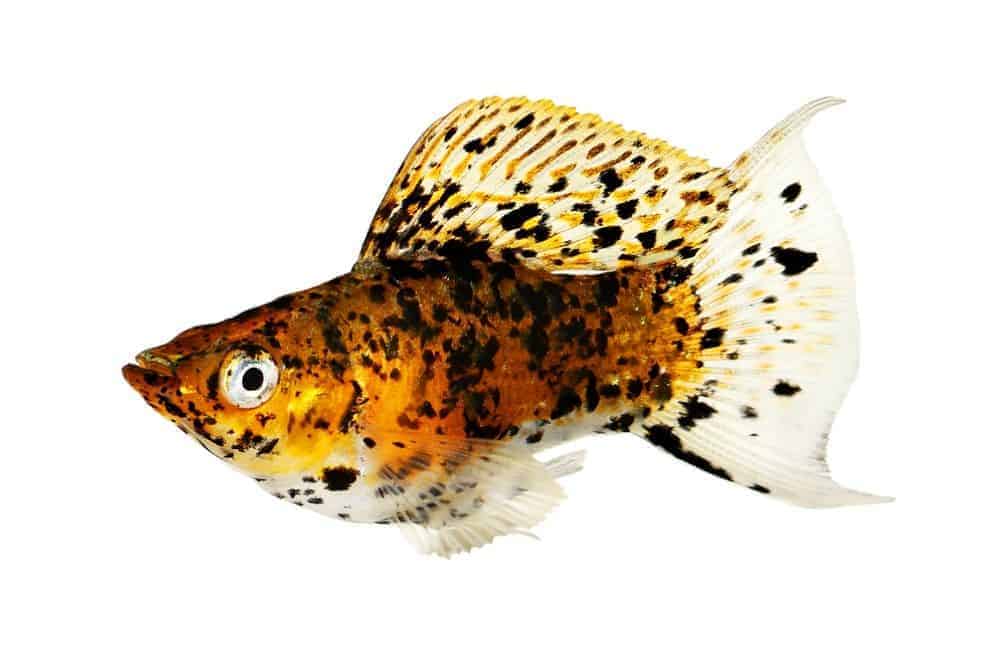
When acquiring these fish, always check whether they have been kept in brackish water previously, so that you can adjust the conditions in their tank accordingly to ensure a trouble-free period of acclimatization. Female Sailfin Mollies may produce a brood of more than 100 fry as regularly as every six weeks.
The height of the dorsal fin in their offspring can vary greatly, because of crossings involving the Pacific Mexican Molly and the other sailfin form, P. latipinna, which has a shorter, less impressive dorsal fin. Like other mollies, Sailfins will live in groups, but it is important to house several males together; if there are just two, the weaker individual will inevitably be bullied.
Summary
Because mollies do tend to create a little bit more ways than some other fish species, it is recommended that you keep them in a highly filtered tank. When you are setting up a tank for your mollies, you will want to decide first if you’re going to set up a brackish or freshwater tank for them, as it is widespread for mollies to be bred and kept in brackish waters.
If you want to keep mollies in a purely freshwater tank, it might be a good idea to look for a breeder that breeds mollies explicitly only in freshwater. As many of the mollies that you will find in popular pet stores were bred in brackish water, they may not do well immediately switching over to freshwater.

Hi, my name is Sean, and I’m the primary writer on the site. I’m blogging mostly about freshwater and saltwater aquariums, fish, invertebrates, and plants. I’m experienced in the fishkeeping hobby for many years. Over the years I have kept many tanks, and have recently begun getting more serious in wanting to become a professional aquarist. All my knowledge comes from experience and reading forums and a lot of informative sites. In pursuit of becoming a professional, I also want to inspire as many people as I can to pick up this hobby and keep the public interest growing.
Read more about Sean.
Please join also my Facebook group.

